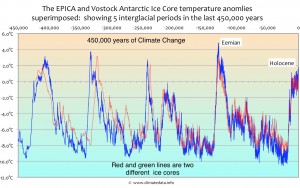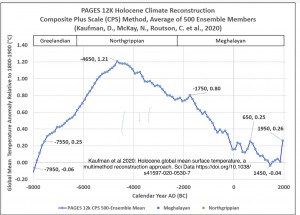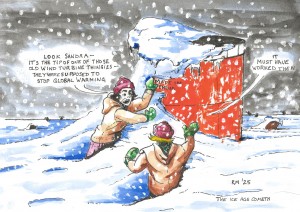The Ice Age Cometh – climate change explained in three graphs [1]
So, geologists observe, a cycle
Hath smaller cycles that on them prey
And these have yet smaller ones to bite ‘em
And so proceed ad infinitem
Thus, every Era in its kind
Repeats all those that come behind
RM (acknowledgments to Jonathon Swift, 1733)
The Big Picture
An Ice Age is a significant period of time (millions of years) when permanent ice exists at both poles. In the Earth’s 4,600,000,000-year-long history (4.6Ga) we have good evidence for at least 7 Ice Ages, but there were probably more. Each lasted around 20-50 million years and together make up around 4% of geological time. Ice Ages are not regularly spaced in time, and they show no apparent correlation with major tectonic events or atmospheric CO2 levels.
What caused them? Speculative theories abound but we just don’t know.
The last of the Ice Ages, known to geologists as the Quaternary Ice Age, began around 2.5 million years ago. We live within a subdivision of the Quaternary called the Holocene - a brief period of relative warmth. It is called an interglacial and began – rather abruptly – around 15-13,000 years ago.
The Holocene itself is one of a series of a series of at least 40 similar brief pauses and partial retreats of ice within the Quaternary Ice Age, each of which lasted 10-15000 years. The interglacial that immediately preceded the Holocene is called the Eemian - none of the others have been given names, at least that I know of. The Eemian reached its maximum warmth around 120,000 years ago.
We do not know how long the Quaternary Ice Age will last, but on the evidence of previous Ice Ages, it probably has many tens of millions of years to run. This post should technically be called The Glaciers Cometh. We already live in an Ice Age.
A Reflection on Deep Time
Earth’s history is divided into four vast periods of time called Eons. Eons are then subdivided into increasingly shorter periods of time known as Eras, Periods, Epochs and Stages. Using geologist’s shorthand, where Ka is one thousand years: Ma is 1 million years and Ga is 1 billion years, the Eons are:
the PHANEROZOIC (0 to 543Ma).
the PROTEROZOIC (543Ma-2.5Ga).
the ARCHAEAN (2.5Ga-4Ga) and..
the HADEAN (4Ga-4.6Ga).
With our short life spans and even shorter memories we have trouble comprehending these gulfs of time. This can lead us to overestimate the significance of the age in which we live. It is a form of hubris.
It may help to realize that, on comparative geological/human time scales, the Hadean Eon commenced 20 years ago and the Phanerozoic 6 months ago. Eight days ago, towards the end of the Phanerozoic in an Era called the Mesozoic, dinosaurs roamed the land, sea and air and appeared masters of their universe (then the meteor struck). An Ice Age called the Quaternary began around 20 hours ago. The evolution of our genus Homo from ape ancestors is a Quaternary story. Five minutes ago, during a brief Stage of ice retreat and relative warmth in the Quaternary called the Holocene, an explosion of innovation enabled our civilisation to take off and thrive.
The lifetime experience of a single human being comes and goes in less than a second.
Such a timetable should teach us humility.
Climate Change Over the Past 540 million Years (the Phanerozoic Eon)
The Phanerozoic began around 540 Ma ago. Its start is defined by an explosion of complex new life forms which as the Eon advanced were able to spread from the oceans to colonise every ecological niche on land. Global temperatures during the Phanerozoic were generally much higher than today, as were the concentrations of oxygen and CO2 in the atmosphere. Warmth, CO2 and oxygen are essential enablers and drivers of evolution.
Figure 1: 543Ma (million years) of Climate Change. The horizontal axis shows millions of years before present. On the vertical axis, temperatures are estimated from rock proxies. Average temperature during these 540Ma was 20°C, but range from 28° to minus 12° (In 2016 it was 14°). PETM=Paleocene-Eocene Thermal Maximum (55.8Ma); EEOC=Early Eocene Climate Optimum (42Ma); MECO=Mid-Eocene Climate Optimum (15-30Ma); EOT=Eocene-Oligocene Transition (40-33Ma); MMCO=Mid-Miocene Climate Optimum (15-13Ma); LGM-Last Glacial Maximum (21Ka); PAW= Post-Anthropogenic Warming (a projected future temperature from IPCC worst-case computer models). White stars indicate rapid cooling events: black stars rapid warming events. Reference: Christopher R Scotese, 2016 (Northwestern University) – Phanerozoic Temperature Curve. Palaeomap Project, Evanston II.
The Quaternary Period is the last of the major subdivisions of the Phanerozoic. It was preceded by 60 million years of slow cooling from the peak Hothouse conditions the of Late Cretaceous Period. The evolution of our species from arboreal primates to upright, bi-pedal, large-brained, opposable-thumbed, stone-tool-using modern humans began around 2.5 million years ago. We are a Quaternary Ice Age species.
We do not know how long the Quaternary Ice Age will last. The evidence of previous Ice Ages suggest it still has many tens of millions of years to go.
Climate Change over the Past 543,000 thousand Years (the Latter Part of the Quaternary Period)
During the Quaternary, glaciers repeatedly advanced south and north from the poles, covering land and sea in kilometer-thick ice, sculpting the earth beneath. Sea levels rose and fell by more than 100 meters. Some species became extinct, new species (including ours) evolved. The habitats of almost all were widely redistributed. Again, and again and again.
If we bore down into the Quaternary, we see a pattern of repeated advances and retreats of the ice: 100-150 thousand years of ice advance followed by 10–15-thousand-year intervals of retreat and moderately-warm weather. We call these brief intervals Interglacials. Through the Quaternary there were dozens of these glacial/interglacial cycles. They are called Dansgaard-Oeschger Cycles after the two Danish scientists who first defined them. You can see the last five D-O cycles in the graph below (figure 2). It is widely accepted that D-O events were caused by minor variations in the amount of solar radiation reaching the earth as a result of predictable wobbles in the tilt of the Earth’s axis and variations of its orbit around the sun: astronomical factors Milankovic Cycles.
To summarise: we live in the Holocene, one of dozens of brief interglacials within the ongoing of the Quaternary Ice Age. The previous Interglacial is called the Eemian. The coldest point between the Eemian and the Holocene is known as the Last Glacial Maximum and occurred around 21 thousand years ago (21Ka). Although the Holocene has overarching significance for humans, it has no particular geological significance.
Figure 2: The graph covers the period from 540 thousand years ago (540Ka) to present – the last 20% of the Quaternary Ice Age. It shows air temperature (blue line) and CO2 concentration (red line) above the Antarctic continent. These are measured from air bubbles trapped in ancient ice which has been recovered by means of deep drilling.
Ice cores provide our best calibrated proxy data and offer 10-year resolution. That data is broadly consistent with results from other types of proxy data from around the globe.
Note: CO2 concentrations show good correlation with air temperature, but their highs and lows occur 500-1000 years after the corresponding peaks and troughs of temperature. This suggests that temperature controls CO2 (with a multi-century lag), not the other way around.
Reference www.climatedata.com
Aside:
During the Eemian Interglacial (which was warmer than today) hippopotami gamboled in the River Thames. 100,000 years later, with the arrival of the Holocene, human civilisation took off, and large mammals gamboled once again on the Thames.
Climate Change over the Past 10 thousand Years (the Holocene Stage)
As you can see from figure 2 above, all the interglacials of the Quaternary for which we have good data followed a similar pattern – a rapid 8°-10°C rise in air temperature over a just a few decades, followed by a slow fall over the succeeding millennia. The relentless fall of temperatures from the Holocene Climate Optimum of 8-4000 years ago (figure 3 below) matches this pattern and is an ominous pointer to what is in store for us.
Figure 3: A compilation of global average surface temperature over the past 10,000 years. It is based on a compilation different types of proxy data (ice cores, tree rings, deep-sea sediments) from around the globe. Note the steep initial rise in Holocene temperature to a maximum around 8-9000 years before present (BP) followed by a slow and gradual decline to the deep trough and harsh conditions of the Little Ice Age at around 600-175BP. The steep upward spike at the right of the graph is called the Modern Warm Period. It results, at least in part, from the splicing of 160 years of thermometer data with 1-day resolution onto the end 10,000 years of 100-year resolution proxy data. Such a brief spike in temperature, if it had existed in the pre-thermometer era, would have been smoothed out in the proxy-generated part of the curve.
Source: Nature Sci Data 7, 201 (2020). https://doi.org/10.1038/s41597-020-0530-7
Will we survive the next ice advance?
The Modern warming trend (which began around 175 years ago – a geological microsecond)- gives faint hope of a delay in the inexorable return of the glaciers. But when that happens, be it in 100-, 500- or 1000-years’ time, as a species we will surely survive. After all, with lesser technology, we survived the last advance of the ice. But will our civilisation?
Our few descendants (as they shiver before the fire in their caves or trudge through the snow in their furs) will look back with puzzlement on the Global Warming concerns of their 21st Century ancestors.
[1] The average global temperature of the lower atmosphere – the Troposphere, where all weather is generated – is the most fundamental single measure of global climate. The three graphs I present seek to show the change in tropospheric temperature over increasingly longer periods of geological time as we look back from the present day. The graphs summarize the best and most up to date I can locate, but their detail will inevitably be modified as knowledge advances. The further back in time, the greater the uncertainty and the coarser the resolution. It should also be noted that global trends may be amplified or smoothed by regional factors.
Click for higher resolution images.


